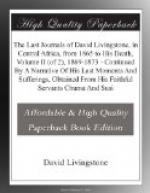By making a ten days’ detour at “Jua Singa,” and travelling by a path well known to one of their party through the jungle of Poli ya vengi, they hoped to keep out of harm’s way, and to be able to make the cloth hold out with which they were supplied. At length the start was effected, and Dr. Dillon likewise quitted the Expedition to return to the coast. It was necessary to stop after the first day’s march, for a long halt; for one of the women was unable to travel, they found, and progress was delayed till she, the wife of Chowpereh, could resume the journey. There seem to have been some serious misunderstandings between the leaders of Dr. Livingstone’s party and Lieut. Murphy soon after setting out, which turned mainly on the subject of beginning the day’s march. The former, trained in the old discipline of their master, laid stress on the necessity of very early rising to avoid the heat of the day, and perhaps pointed out more bluntly than pleasantly that if the Englishmen wanted to improve their health, they had better do so too. However, to a certain extent, this was avoided by the two companies pleasing themselves.
Making an early start, the body was carried to Kasekera, by Susi’s party where, from an evident disinclination to receive it into the village, an encampment was made outside. A consultation now became necessary. There was no disguising the fact that, if they kept along the main road, intelligence would precede them concerning that in which they were engaged, stirring up certain hostility and jeopardising the most precious charge they had. A plan was quickly hit upon. Unobserved, the men removed the corpse of the deceased explorer from the package in which it had hitherto been conveyed, and buried the bark case in the hut in the thicket around the village in which they had placed it. The object now was to throw the villagers off their guard, by making believe that they had relinquished the attempt to carry the body to Zanzibar. They feigned that they had abandoned their task, having changed their minds, and that it must be sent back to Unyanyembe to be buried there. In the mean time the corpse of necessity had to be concealed in the smallest space possible, if they were actually to convey it secretly for the future; this was quickly managed.
Susi and Chuma went into the wood and stripped off a fresh length of bark from an N’gombe tree; in this the remains, conveniently prepared as to length, were placed, the whole being surrounded with calico in such a manner as to appear like an ordinary travelling bale, which was then deposited with the rest of the goods. They next proceeded to gather a faggot of mapira-stalks, cutting them in lengths of six feet or so, and swathing them round with cloth to imitate a dead body about to be buried. This done, a paper, folded so as to represent a letter, was duly placed in a cleft stick, according to the native letter-carrier’s custom, and six trustworthy men were told off ostensibly




